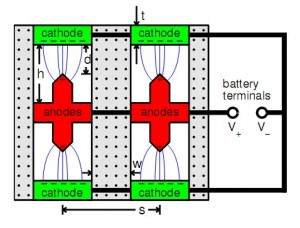
FIG. 2: Schematic of an array of four vacuum nano tubes (cross section, side view). The cathode (− − −) is a planar. The anode (+ + +) is a nano tip on a flat electrode. The thin curved lines indicate the electric field lines. The cathode is a conducting solid with high tensile strength, such as tungsten or steel. The flat part of the anode needs to have a high tensile strength, such as steel. The nano tip is a conducting solid with extremely high tensile strength, such as a carbon nanotube clamped to the steel electrode, or a tungsten Spindt-tip [7]. The design of the electrodes is similar to a tunneling microscope, except that tunneling microscopes have one movable tip, whereas the vacuum tube arrays have many stationary tips. The insulating walls (dots) are solids with a high compressive strength, such as silicon oxides. The electrodes and the walls create a vacuum tube. The electric field is in the vacuum tube between the anode tip and the cathode.
Digital quantum batteries: Energy and information storage in nano vacuum tube arrays
Alfred W. Hubler and Onyeama Osuagwu
Department of Physics, University of Illinois at Urbana-Champaign,
1110 W Green Street, Illinois 61801, USA
(Dated: September 22, 2009)
Abstract
Dielectric material between capacitor electrodes increases the capacitance. However, when the electric field exceeds a threshold, electric breakdown in the dielectric discharges the capacitor suddenly and the stored energy is lost. We show that nano vacuum tubes do not have this problem because (i) electric breakdown can be suppressed with quantization phenomena, and (ii) the capacitance is large at small gap sizes. We find that the energy density and power density in nano vacuum tubes are large compared to lithium batteries and electrochemical capacitors. The electric field in a nano vacuum tube can be sensed with MOSFETs in the insulating walls. Random access arrays of nano vacuum tubes with an energy gate, to charge the tube, and an information gate attached to the MOSFET, to sense the electric field in the tube, can be used to store both energy and information.
PACS numbers: 52.80.Vq 68.37.Vj 85.35.-p
Electronic address: a-hubler@uiuc.edu
Source